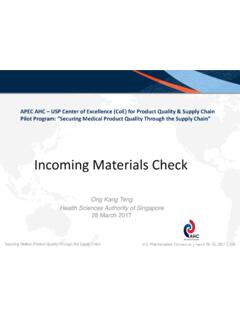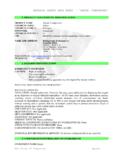Transcription of Ammonia Handling Manual - Hydro Instruments
1 Hydro Instruments 600 Emlen Way Telford, PA 18969 Phone: Fax: Email: Web Address: Specifications subject to change without notice. 2013 Hydro Instruments Ammonia Handling Manual Ammonia Handling Manual The information contained in this Manual was accurate at the time of printing. The most current versions of all Hydro Instruments manuals can be found on our website NH3-001 Rev. 02/14/13 Hydro Instruments 600 Emlen Way Telford, PA 18969 Phone: Fax: Email: Web Address: Specifications subject to change without notice. 2013 Hydro Instruments Ammonia Handling Manual Ammonia Handling Manual Table of Contents I.
2 II. Ammonia Uses and III. Safety Information ..5 1. General Health Hazards, Emergency Equipment & Emergency Action Plans..5 2. Ammonia Storage IV. Ammonia 1. 2. Withdrawal V. Storage and Use of VI. Pressure Manifolding, Piping and Other Ammonia Line 1. Auxiliary 2. Flexible 3. Manifold/Pressurized 4. 5. Pressure 6. Expansion 7.
3 Pressure Reducing 8. VII. Preparing Piping For VIII. Vacuum Piping and Other Ammonia Line IX. Ammonia Absorption and 1 Hydro Instruments 600 Emlen Way Telford, PA 18969 Phone: Fax: Email: Web Address: Specifications subject to change without notice. 2013 Hydro Instruments Ammonia Handling Manual Warning Ammonia is a hazardous chemical that can cause injury and death if not handled properly. This Manual contains only general information on the physical properties, storage, and Handling of Ammonia containers and relevant equipment. It is not intended to replace or limit safety procedures in your facility.
4 Safety procedures in an industrial setting must be designed in accordance with all governmental regulations and national safety codes, after giving full consideration to the specific needs of the industrial facility involved. Under no circumstances should the information in this Manual be construed as substituting or superseding any local, state, or federal laws and regulations. Hydro Instruments cannot anticipate the specific safety procedures required at every industrial facility. Accordingly, Hydro Instruments does not guarantee that safety procedures designed in accordance with this Manual will completely eliminate hazards and thus assumes no liability for accidents that may occur in your facility.
5 Read this entire Manual and be fully familiar with your equipment and your entire industrial system so that the safety procedures you establish will meet the needs of the employees in you facility. Reading only part of the Manual will not help you analyze the needs of your facility. Contact your Ammonia suppliers, and other similar organizations to obtain any MSDS and/or more information. All information in this Manual was current at time of printing. Please note the date of printing and possible obsolescence of material as a result of scientific and medical developments after the date of publication. This applies to all materials you review in the course of developing safety procedures for use at you facility.
6 When working with Ammonia Ensure that approved, self-contained breathing apparatuses are always available and personnel are properly trained for its use. Safety equipment should be inspected and maintained in accordance with the manufacturer s instructions. Ensure that all warning signs and placards are in their appropriate place and can clearly be displayed. In the event of a leak, use proper safety equipment and trained personnel to respond to the leak immediately. Evacuate all personnel in a dangerous area to a safe space. If breathing has stopped perform respiration immediately. If heart has stopped perform CPR.
7 Knowledgeable design personnel should oversee and approve equipment installation and suitability of the system for which it is intended. Qualified personnel should also perform routine equipment checks and maintenance in accordance with manufactures recommendations and instructions. 2 Hydro Instruments 600 Emlen Way Telford, PA 18969 Phone: Fax: Email: Web Address: Specifications subject to change without notice. 2013 Hydro Instruments Ammonia Handling Manual I. INTRODUCTION Warning: Ammonia is a hazardous and dangerous chemical. Take extreme care when Handling and follow all pertinent safety rules and regulations.
8 This Manual was designed for the reader to understand the proper Handling , storage, service and delivery of Ammonia . This Manual should be read fully and understood before Handling any containers or equipment. It is also suggested that the reader read all relevant material safety data sheets and contact your chemical supplier for more information. II. Ammonia USES AND PROPERTIES Ammonia is widely used in the water and wastewater treatment industry to create chloramines for disinfectant purposes. Chloramines can provide adequate disinfection without as much generation of the harmful disinfectant by-products. Ammonia is also used in the production of fertilizer, as the primary ingredient in smelling salt, and many other chemical industries.
9 In commerce, Ammonia is stored as a liquefied gas under pressure. It is colorless in both the gas and liquid phases, but Ammonia gas is easily detected by its characteristic sharp, pungent odor at high enough concentrations. In the absence of moisture, Ammonia is a relatively non-corrosive substance. However, in the presence of moisture is becomes a highly corrosive compound. This is important as there are many grades of Ammonia available, all with different moisture content. Review with the chemical supplier as to what grade should be used. Ammonia gas and liquid can be lethal to human life above certain concentrations (see section III) by attacking the skin and lungs/respiratory system.
10 Ammonia is not considered a fire hazard at normal operating conditions. However, at temperatures above 1562 F (850 C) fires can occur in air at Ammonia concentrations of 16-25 %. Ammonia can also form explosive compounds with bromine, chlorine, iodine, mercury, silver oxide, or hypochlorites so exposure and the potential of exposure of Ammonia to chemicals should be avoided. Extreme caution should be used when dealing with Ammonia and material safety data sheets should be read and understood before Handling . Other important properties can be found in table 1. 3 Hydro Instruments 600 Emlen Way Telford, PA 18969 Phone: Fax: Email: Web Address: Specifications subject to change without notice.










